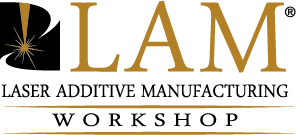
Orlando, FL (April 1, 2015) – Held in Orlando for the first time in its seven-year history, LIA’s Laser Additive Manufacturing Workshop (LAM®) drew nearly 200 attendees, about half of them first-time participants who got a real-world view of the profit potential and pitfalls of industrial 3D printing.
Featuring speakers from BMW, Siemens, GE Global Research and the Fraunhofer institutes, LAM 2015 showcased how researchers, powder suppliers, laser manufacturers, job shops and national initiatives are cooperating to advance applications in various industries. From unique job shop successes to visions of printing human tissue, attendees were treated to a broad range of expert knowledge March 4-5 — including state-of-the-art strategies to eliminate cracking, clad large parts and build high-value components.
Keynote speaker Christoph Leyens of Fraunhofer IWS illustrated the potential material and cost savings of layer-by-layer, near net shape manufacturing — for example, a potential reduction of up to 5,000 euros per part when producing a strongly twisted Ti64 leading edge for an aviation fan blade with AM vs. conventional machining.
Meanwhile, BMW’s Wolfgang Thiele demonstrated how the automaker uses additive processes to produce more than 100,000 parts a year for its prototyping department. Furthermore, BMW has made more than 600 parts for its motor sports division, using aluminum alloy and the ReaLizer 250 machine for a complex engine component requiring undercuts.
To foster additive thinking among engineers, LAM co-chair Jim Sears of GE Global Research noted that 100 desktop 3D printers have been given to 1,000 members of an in-house makers’ guild extending to GE’s aviation, corporate, health-care, oil and gas, power and water, appliances and lighting divisions.
Highlighting cladding applications, President Wayne Penn of Platinum Sponsor Alabama Laser detailed a unique laser material deposition procedure to repair water wall panels, which are made up of multiple boiler tubes welded together and ranging from 10 to 40 feet long and up to 5 feet wide. Instead of moving the part to clad these undulating 3D surfaces with a fixed beam, Alabama Laser developed a flying-optic system for which a patent is pending.
Forays into higher speed multibeam additive manufacturing included Henner Schöneborn of SLM Solutions discussing the company’s Quad Laser Technology using four 400- to 700-watt fiber lasers. Max Schniedenharn of Fraunhofer ILT detailed a selective laser melting approach using a line of five diode lasers that can be switched on and off as part geometries dictate.
“We tried to address the entire process chain on the first day,” said LAM General Chair Ingomar Kelbassa, “from the raw material and design through additive manufacturing (AM) processes to adaptive finishing operations like five-axis milling. On the second day, we talked about what creates more awareness and visibility” of laser-based additive manufacturing.
Kelbassa, an adjunct professor at Australia’s RMIT University, hoped the success stories shared during LAM 2015 helped veterans and newcomers “get motivated for additive manufacturing in the future.”
LAM returns to Orlando on March 2-3, 2016, when past general chair Paul Denney of Lincoln Electric returns to the helm. Visit www.lia.org/lam for updates.
About LIA
The Laser Institute of America (LIA) is the professional society for laser applications and safety serving the industrial, educational, medical, research and government communities throughout the world since 1968. www.lia.org, 13501 Ingenuity Drive, Ste 128, Orlando, FL 32826, +1.407.380.1553.
###
